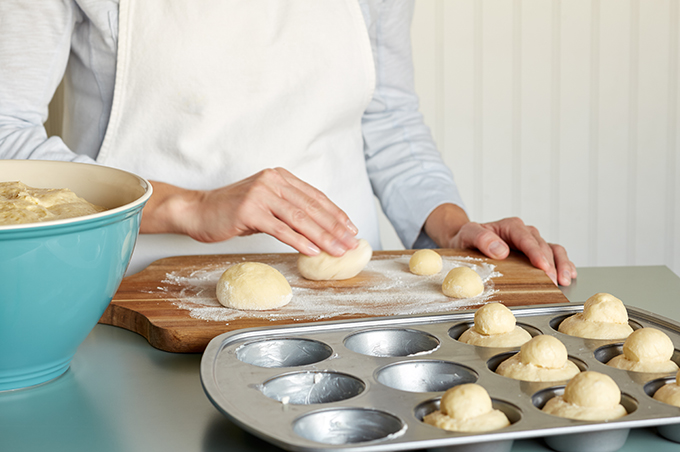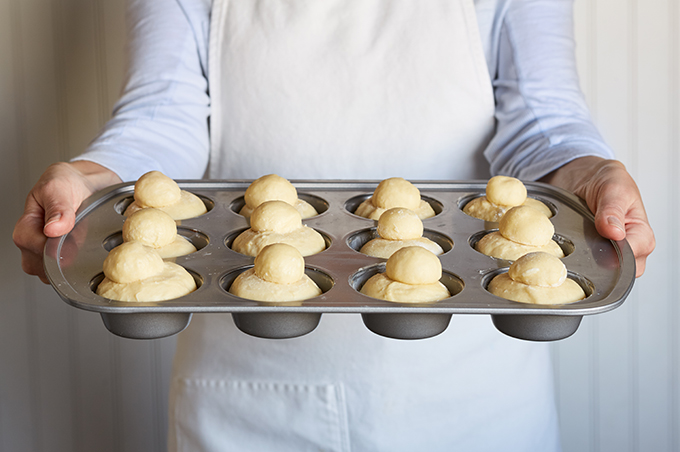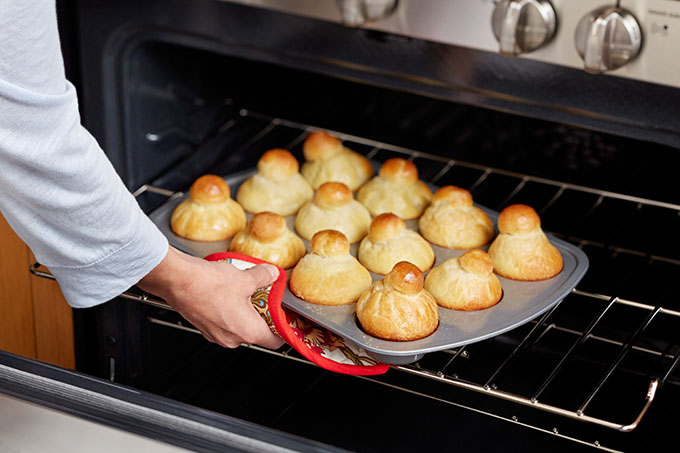Bread or pastry? Brioche is something of a chameleon. Rich enough to play nicely with fruit and chocolate, yet tough enough to stand up to burgers, brioche works in myriad applications, from breakfast all the way through to dinner and even dessert. It’s also rich in history; when the French Revolution threatened to topple Marie Antoinette’s castle walls, the famously out-of-touch queen advised that the poor eat brioche, not cake, as the story is so often retold. “Qu’ils mangent de la brioche,” she said: “Let them eat brioche.”
Butter and eggs provide the richness that makes brioche more than just bread. In the French baking tradition, brioche belongs to the category of viennoiserie, baked goods that are neither strictly bread (boulangerie), nor cakes or confections (patisserie). While the method for making brioche is similar to that of making bread, brioche boasts a much higher butter and egg content; in our recipe for Brioche Buns, for example, we use one and one-half sticks of Challenge Butter and five large eggs to make just 12 buns.
The historical role of butter in brioche is particularly interesting. When the Vikings entered Northern France in the ninth century, they brought with them cows whose milk included a very high proportion of cream. At the time, butter wasn’t considered an ingredient so much as a byproduct of dairy work, consumed almost exclusively by those who owned cows. These Norman dairy farmers worked the excess butter into their bread dough, enriching its flavor, and extending its shelf life; and brioche was the result.
Traditionally baked in fluted, flared tins as buns (brioche à tête and petite brioche), today, brioche is baked into multiple shapes for multiple uses. With their loft and tight, sturdy texture, brioche buns have become a preferred medium for gourmet burgers in the modern kitchen. Brioche dough is also often used to encrust fillings for entrees and appetizers. Sliced or cubed, brioche holds its shape beautifully in bread pudding, French toast and panzanella (Tuscan bread salad). For the ultimate grilled cheese sandwich, two thick slices of buttery brioche bread can’t be bested. But perhaps the simplest and most decadent way to savor a brioche bun is oven-warm, torn-open and topped with a smear of fruit preserves.



Ingredients
- 1 cup warm milk
- 3 Tablespoons sugar
- 1 package active dry yeast
- 4 large eggs
- 4 cups flour
- 2 teaspoons salt
- 12 Tablespoons Challenge Butter, room temperature
- 1 egg, for glaze
Directions
-
1
Combine warm milk and sugar in bowl of mixer fitted with paddle attachment.
-
2
Sprinkle with yeast, stir to combine and let sit for about 8 minutes or until fully dissolved.
-
3
Beat in eggs until thoroughly mixed and then add flour (bread flour if making burger buns) and salt. Continue to beat on medium high speed about 3 to 5 minutes or until is dough is smooth.
-
4
Change mixer to dough hook and while on low beat in butter 1 tablespoon at a time. Continue to beat dough for about 8 minutes or until shiny.
-
5
Scrape the dough into a medium size buttered bowl. Cover with plastic wrap and let dough double in bulk. Once doubled deflate dough, recover with plastic wrap and refrigerate overnight.
-
6
For brioche buns, remove dough from fridge and divide into four equal parts. Using three of the sections, roll out 12 large balls, and with the remaining section, roll out 12 small balls. Place the large balls in the buttered muffin tin and top each with a small ball. Cover lightly and allow to rise until doubled, about 1 to 1 1/2 hours.
-
7
For hamburger buns, divide dough into twelve equal pieces and shape into balls. Place them on a parchment lined baking sheet. Cover lightly with plastic wrap and allow to rise.
-
8
Preheat oven to 350 F. Whisk the egg with 2 tablespoons of water. Brush on tops of buns. Bake about 20 minutes.

